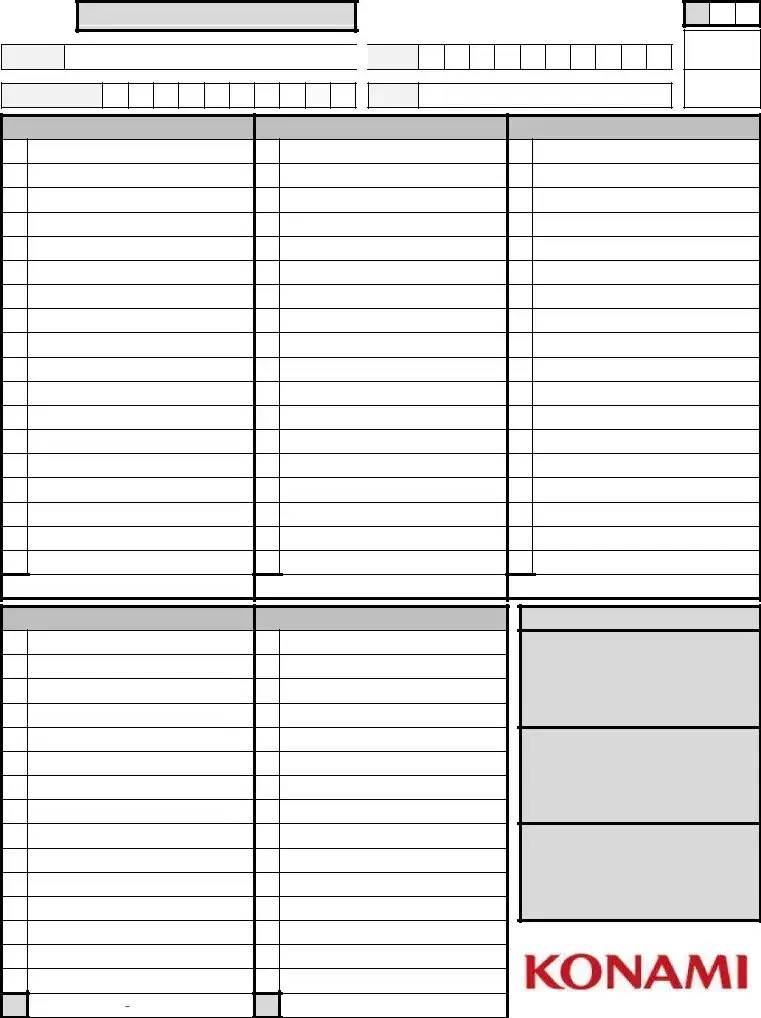What is the Konami Decklist form?
The Konami Decklist form is a document used by players participating in official Konami card game tournaments to register their deck. This form ensures that players list all cards in their deck, including the Main Deck, Side Deck, and Extra Deck, in a clear and detailed manner before playing in the event.
Why is it important to write all card names completely and legibly?
Writing card names completely and legibly is crucial for transparency and fairness. It allows judges and tournament officials to easily verify that a player's deck is legal for the tournament, follows all rules, and matches what the player claims to be using. This helps in preventing misunderstandings and disputes during games.
What does the 'Konami Player ID' field refer to?
The 'Konami Player ID' field refers to the unique identifier given to each player who participates in official Konami events. This ID is used to track a player’s performance, rankings, and participation across different tournaments and events.
Why are there sections for the Main Deck, Side Deck, and Extra Deck?
The Main Deck, Side Deck, and Extra Deck sections are designed to organize the different types of cards a player can bring to a tournament. The Main Deck is used in every game, while the Side and Extra Decks allow players to swap in cards between games of a match, enabling strategic adjustments based on the opponent's tactics or deck type.
What is the purpose of the 'Judge Use Only' section?
The 'Judge Use Only' section is for tournament officials and judges to record their checks and findings related to a player's deck. This includes verification that the deck list matches the actual deck used in play, noting any infractions, and tracking deck checks throughout the tournament. This section helps maintain the integrity of the game.
How should the quantity for each card be included?
The quantity for each card should be clearly indicated next to the card name on the form. This specifies how many copies of each card are present in the Main Deck, Side Deck, or Extra Deck, ensuring clarity and compliance with tournament deck construction rules.
What happens if there are mistakes or illegible entries on the form?
Mistakes or illegible entries can lead to misunderstandings, penalties, or even disqualification from the tournament. It's essential for players to carefully review their decklist form for accuracy and clarity before submission to avoid any issues during the event.
Can changes be made to the decklist once it has been submitted?
Generally, changes are not allowed to the decklist once it has been submitted. The submitted decklist is considered final and must be adhered to throughout the tournament. Players are encouraged to double-check their deck list for accuracy and completeness before submitting it.
What should be done if a player finds an error in their decklist after submission?
If a player discovers an error in their decklist after submission, they should immediately inform a judge or tournament official. Depending on the rules of the specific tournament and the nature of the error, officials may provide instructions on how to proceed. Honesty and prompt reporting are crucial in these situations.




 <<< Total Monster Cards
<<< Total Monster Cards <<< Total Spell Cards
<<< Total Spell Cards <<< Total Trap Cards
<<< Total Trap Cards